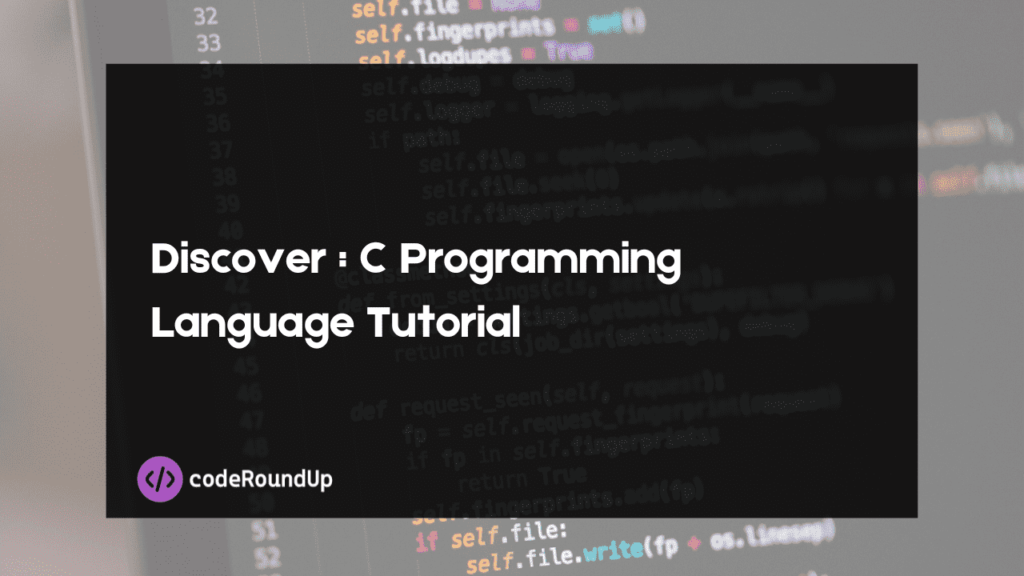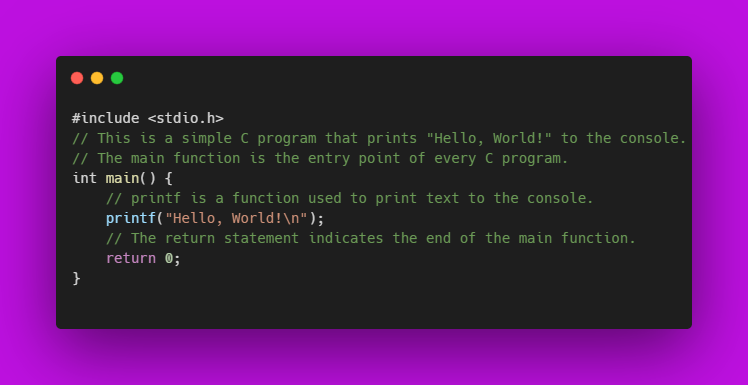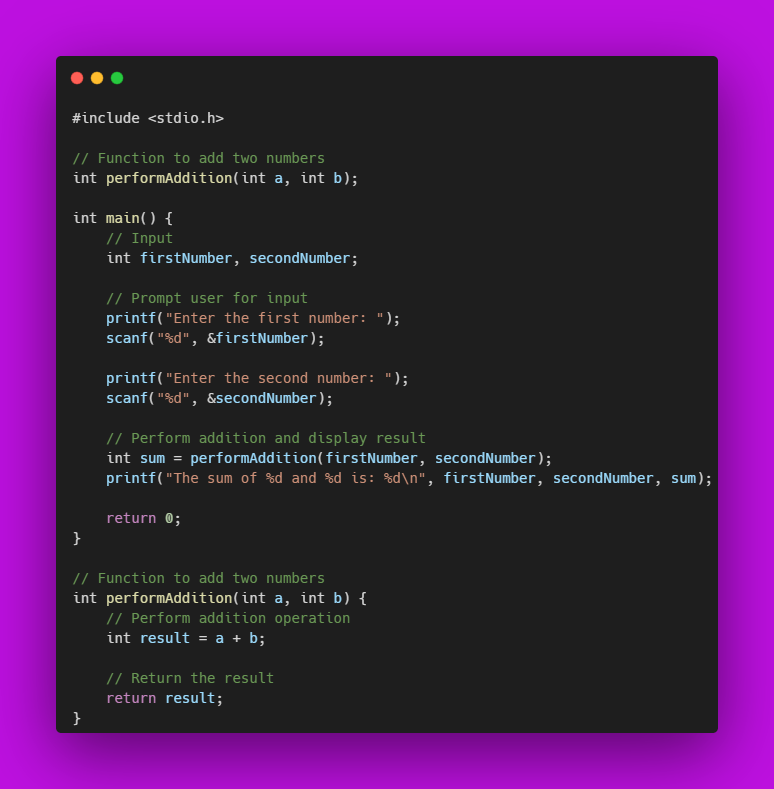
Welcome to the C Programming Language Tutorial! Learn the basics of C, a powerful and versatile programming language. This guide covers fundamental concepts like data types, functions, arrays, and pointers. Whether you’re a beginner or an experienced developer, this tutorial provides hands-on examples to solidify your skills. Let’s dive into the world of C programming!
What Is C Programming?
Brief History of C
Let’s go back in time to when C programming was born. It all began with smart folks named Dennis Ritchie and Brian Kernighan. They worked together, creating something special that would later become the C language.
Characteristics of C
Here, we delve into the defining features of C that make it stand out among programming languages. The emphasis is on efficiency, portability, and versatility, showcasing why C has endured as a preferred language for developers across various domains.
Importance of Learning C
This section underscores the practical applications of C, focusing on its role in systems programming and embedded systems. We also stress its value as a stepping stone for acquiring proficiency in other programming languages, providing a compelling argument for readers to invest time in learning C.
Setting Up the Development Environment
Installing a C Compiler
Step-by-step instructions are provided for installing GCC, a widely used C compiler, on different operating systems. This ensures readers can easily set up their development environment, a crucial initial step for anyone venturing into C programming.
Setting Up an IDE
We introduce popular Integrated Development Environments (IDEs) such as Code::Blocks and Visual Studio Code. This information aids readers in choosing the right environment based on their preferences, fostering a comfortable and efficient coding experience.
Basic Structure of a C Program
Header Files (#include)
This section elucidates the significance of header files in C programming. We demonstrate how to include them in a program, clarifying their role in enhancing code modularity and functionality.
The Main Function
The main function is explored in detail, explaining its pivotal role as the entry point of a C program. This section ensures readers grasp the fundamental structure of a C program and how execution begins.
Comments
We emphasize the importance of code documentation through comments. Practical examples are provided, illustrating how comments enhance code readability and understanding.

Variables and Data Types Of C Programming Language Tutorial
Declaration and Initialization
Readers are guided through the process of declaring and initializing variables, accompanied by illustrative examples. This foundational knowledge is essential for writing effective C programs.
Basic Data Types
We explore the various basic data types in C, including integers, floating-point numbers, and characters. A clear understanding of these types is crucial for manipulating and storing data effectively.
Constants
The concept of constants is introduced, explaining their use and importance in C programming. This knowledge aids in creating robust and maintainable code.
Example
#include <stdio.h>
// Constants
#define PI 3.14
const int MAX_VALUE = 100;
int main() {
// Data Type Declaration and Initialization
int integerVar = 42;
float floatVar = 3.1415;
char charVar = 'A';
double doubleVar = 2.71828;
// Displaying Values
printf("Integer Variable: %d\n", integerVar);
printf("Float Variable: %f\n", floatVar);
printf("Char Variable: %c\n", charVar);
printf("Double Variable: %lf\n", doubleVar);
// Using Constants
printf("Constant PI: %f\n", PI);
printf("Constant MAX_VALUE: %d\n", MAX_VALUE);
return 0;
}
Input and Output
printf and scanf Functions
Practical examples demonstrate the usage of printf and scanf functions for formatted input and output. This section ensures readers can interact with users and display information effectively.
Formatted Output
Different formatting options for various data types are explored, enhancing the presentation of output. This section emphasizes the importance of clear and organized output in programming.
#include <stdio.h>
int main() {
int num1 = 10;
float num2 = 3.14;
char character = 'A';
// Using printf for formatted output
printf("Integer: %d\n", num1);
printf("Float: %.2f\n", num2);
printf("Character: %c\n", character);
return 0;
}
In this example, %d, %.2f, and %c are format specifiers used with printf to specify the type of data to be printed and how it should be formatted. The \n is used for a newline character to improve the readability of the output.
Operators
Arithmetic Operators
This section covers basic arithmetic operations, such as addition, subtraction, multiplication, and division, and illustrates their usage in C programming. Understanding arithmetic operators is fundamental for mathematical computations within a program.
Relational Operators
The focus here is on operators used for making comparisons, such as equal to, not equal to, greater than, and less than. Clear examples help readers grasp how to implement these operators effectively in conditional statements.
Logical Operators
Exploring operators used for logical operations, including AND, OR, and NOT. Understanding logical operators is crucial for making decisions and controlling the flow of a program.
Assignment Operators
This section introduces operators for assignment and shorthand assignments. It demonstrates efficient ways to assign values to variables, enhancing code conciseness and readability.
Increment and Decrement Operators
The increment operator is denoted by ++.It adds 1 to the current value of the variable.
There are two forms: post-increment (variable++) and pre-increment (++variable).
Post-increment evaluates the current value of the variable and then increments it.
Pre-increment increments the variable first and then evaluates its value.
The decrement operator is denoted by –.It subtracts 1 from the current value of the variable.
Similar to the increment operator, there are post-decrement (variable–) and pre-decrement (–variable) forms.
#include <stdio.h>
int main() {
// Arithmetic Operators
int a = 5, b = 2;
printf("Arithmetic Operators:\n");
printf("Addition: %d\n", a + b);
printf("Subtraction: %d\n", a - b);
printf("Multiplication: %d\n", a * b);
printf("Division: %d\n", a / b);
printf("Modulus: %d\n", a % b);
// Relational Operators
int x = 7, y = 10;
printf("\nRelational Operators:\n");
printf("%d is equal to %d: %d\n", x, y, x == y);
printf("%d is not equal to %d: %d\n", x, y, x != y);
printf("%d is greater than %d: %d\n", x, y, x > y);
printf("%d is less than %d: %d\n", x, y, x < y);
printf("%d is greater than or equal to %d: %d\n", x, y, x >= y);
printf("%d is less than or equal to %d: %d\n", x, y, x <= y);
// Logical Operators
int p = 1, q = 0;
printf("\nLogical Operators:\n");
printf("AND: %d\n", p && q);
printf("OR: %d\n", p || q);
printf("NOT for p: %d\n", !p);
printf("NOT for q: %d\n", !q);
// Assignment Operators
int c = 8;
printf("\nAssignment Operators:\n");
c += 3; // Equivalent to c = c + 3
printf("c += 3: %d\n", c);
c -= 2; // Equivalent to c = c - 2
printf("c -= 2: %d\n", c);
c *= 4; // Equivalent to c = c * 4
printf("c *= 4: %d\n", c);
// Increment and Decrement Operators
int num = 5;
printf("\nIncrement and Decrement Operators:\n");
printf("Original Value: %d\n", num);
printf("Post-increment: %d\n", num++);
printf("After Post-increment: %d\n", num);
printf("Pre-increment: %d\n", ++num);
printf("After Pre-increment: %d\n", num);
printf("Post-decrement: %d\n", num--);
printf("After Post-decrement: %d\n", num);
printf("Pre-decrement: %d\n", --num);
printf("After Pre-decrement: %d\n", num);
return 0;
}
Control Flow
Conditional Statements
In-depth coverage of conditional statements, including if, else if, and else statements, and a demonstration of the switch statement. Readers gain insights into decision-making structures within C programs.
Looping Statements
Explanation and examples of while, for, and do-while loops. Understanding loop structures is essential for repetitive tasks and efficient program execution.
Break and Continue Statements
Discussion on the use of break and continue statements in controlling loop execution. This section provides readers with tools to optimize and control loops effectively.
Example
#include <stdio.h>
int main() {
// Control statement example
int age = 20;
if (age >= 18) {
printf("You are eligible to vote!\n");
} else {
printf("Sorry, you are not eligible to vote yet.\n");
}
// Loop example
printf("\nLoop example:\n");
for (int i = 1; i <= 5; ++i) {
printf("Iteration %d\n", i);
}
// Break statement example
printf("\nBreak statement example:\n");
for (int j = 1; j <= 10; ++j) {
if (j == 6) {
printf("Breaking the loop at iteration %d\n", j);
break;
}
printf("Iteration %d\n", j);
}
// Continue statement example
printf("\nContinue statement example:\n");
for (int k = 1; k <= 5; ++k) {
if (k == 3) {
printf("Skipping iteration %d using continue statement\n", k);
continue;
}
printf("Iteration %d\n", k);
}
return 0;
}
Functions
Function Declaration and Definition
Guidance on how to declare and define functions in C programming. Understanding functions is crucial for modular and organized code.
Parameters and Return Values
A detailed discussion on the use of function parameters and return values. Readers learn how to pass information into functions and receive results, enhancing code flexibility.
Function Prototypes
Introducing the concept of function prototypes and explaining their importance. This section emphasizes the role of prototypes in ensuring proper function usage throughout a program.
Example

Arrays
Declaration and Initialization
Step-by-step instructions on declaring and initializing arrays in C. Practical examples aid readers in understanding how to work with arrays efficiently.
Accessing Array Elements
Explaining how to access individual elements and traverse arrays. This knowledge is crucial for effective manipulation of data stored in arrays.
Multidimensional Arrays
Introduction to arrays with more than one dimension, providing readers with tools to work with complex data structures.
Example
#include <stdio.h>
int main() {
// Declare and initialize an array
int numbers[] = {1, 2, 3, 4, 5};
// Access and display the values of the array elements
printf("Array Elements: ");
for (int i = 0; i < 5; ++i) {
printf("%d ", numbers[i]);
}
printf("\n");
// Modify the values of array elements
numbers[2] = 10;
numbers[4] = 8;
// Display the modified array
printf("Modified Array: ");
for (int i = 0; i < 5; ++i) {
printf("%d ", numbers[i]);
}
printf("\n");
return 0;
}
Pointers
Introduction to Pointers
A thorough explanation of the concept of pointers and their diverse applications in C programming. Understanding pointers is essential for advanced memory management.
Pointers and Arrays
Demonstration of the relationship between pointers and arrays. Readers learn how pointers can be used to manipulate arrays efficiently.
Pointer Arithmetic
Exploration of basic pointer arithmetic operations, providing insights into memory management practices.
This detailed breakdown of the Operators, Control Flow, Functions, Arrays, and Pointers sections ensures a comprehensive understanding of essential concepts in C programming. Each subheading is accompanied by practical examples to facilitate learning. The article will continue in this manner, covering the remaining topics outlined in the initial prompt.
Strings
String Manipulation
This section delves into common string operations and functions in C, providing practical examples of manipulating strings. Understanding how to work with strings is crucial for various applications, from simple text processing to complex algorithms.
String Input/Output Functions
Introduction to functions like gets, puts, fgets, and fputs for efficient handling of strings. Readers learn how to interact with strings in input and output operations.
strlen() – Tells you how long a word (string) is.
char word[] = "Hello";
int length = strlen(word); // length will be 5strcpy() – Copies one word into another.
char source[] = "Hello";
char destination[20]; // Make sure the destination has enough space
strcpy(destination, source); // Now, destination has "Hello"strcat() – Combines or adds one word to the end of another.
char firstPart[] = "Hello";
char secondPart[] = " World!";
strcat(firstPart, secondPart); // Now, firstPart has "Hello World!"strcmp() – Compares two words to see if they are the same.
char word1[] = "apple";
char word2[] = "orange";
int result = strcmp(word1, word2);
// If result is negative, word1 is before word2.
// If result is positive, word1 is after word2.
// If result is 0, they are the same.strncmp() – Compares only the first few letters of two words.
char part1[] = "apple";
char part2[] = "appetizer";
int result = strncmp(part1, part2, 4);
// Only compare the first 4 letters; result will be 0 because "appl" is the same.strchr() – Finds a specific letter in a word.
char word[] = "Hello";
char *found = strchr(word, 'l'); // found will point to the first 'l'strstr() – Finds a specific word in another word.
char sentence[] = "Hello, how are you?";
char *found = strstr(sentence, "how"); // found will point to "how are you?"sprintf() – Puts formatted data into a word (string).
char buffer[50];
int number = 42;
sprintf(buffer, "The answer is %d", number); // buffer now has "The answer is 42"sscanf() – Reads specific data from a word (string).
char data[] = "Age: 25";
int age;
sscanf(data, "Age: %d", &age); // age will be 25Structures and Unions
Defining Structures
A detailed explanation of how to define structures in C, accompanied by examples. This section demonstrates how structures allow programmers to group related data under a single name.
Accessing Structure Members
Readers learn how to access individual members of a structure, providing insights into effective data management using structures.
Unions and Their Uses
Introduction to unions, explaining how they enable the storage of different data types in the same memory location. This knowledge is valuable for efficient memory utilization.
File Handling
Opening, Reading, and Writing Files
This section explores file operations using functions like fopen, fclose, fread, and fwrite. Practical examples guide readers on how to work with files in C programs.
Error Handling
Addressing common file handling errors and providing strategies for effective error management. Understanding error handling is crucial for robust file operations.
Dynamic Memory Allocation
malloc, calloc, realloc, free
Detailed explanations of dynamic memory allocation functions, including malloc, calloc, realloc, and free. Understanding these functions is essential for managing memory dynamically during program execution.
Memory Management Practices
Discussions on best practices for memory allocation and deallocation. Readers gain insights into writing efficient and memory-friendly C programs.
Example
#include <stdio.h>
#include <stdlib.h>
int main() {
// Declare a pointer to an integer
int *numbers;
// Specify the size of the array
int size = 5;
// Allocate memory for an array of integers
numbers = (int *)malloc(size * sizeof(int));
// Check if memory allocation is successful
if (numbers == NULL) {
printf("Memory allocation failed.\n");
return 1; // Exit the program with an error code
}
// Assign values to the array
for (int i = 0; i < size; i++) {
numbers[i] = i * 2;
}
// Display the values in the array
printf("Array elements: ");
for (int i = 0; i < size; i++) {
printf("%d ", numbers[i]);
}
// Don't forget to free the allocated memory
free(numbers);
return 0; // Exit the program successfully
}
Preprocessor Directives
#define, #include, Conditional Compilation
Explaining the role of the preprocessor and common directives such as #define and #include. Understanding conditional compilation ensures readers can optimize code for different scenarios.
Advanced Topics (Optional)
Enumerations
Introduction to enumerations for creating named constant values. This section provides readers with an additional tool for enhancing code readability and maintainability.
Typedef
An explanation of typedef for creating custom data type aliases. Understanding typedef enhances code clarity and abstraction.
Recursion
Comprehensive discussion on recursive function calls and their applications. Readers learn how to implement recursive algorithms in C.
Function Pointers
Introduction to the concept of function pointers and their diverse uses in C programming. Understanding function pointers provides flexibility in function calls.
Best Practices and Coding Style
Naming Conventions
Exploration of common naming conventions for variables, functions, and other identifiers. Consistent naming enhances code readability and maintainability.
Code Readability
Stressing the significance of crafting code that is clear and easily comprehensible, this segment offers practical advice for enhancing the readability of your code.
Code Organization
Guidance on organizing code into functions and modules. Proper code organization enhances collaboration and maintainability.
Debugging and Troubleshooting
Using Debuggers
Introduction to debugging tools and techniques. Readers learn how to use debuggers for identifying and fixing errors in C programs.
Common Programming Errors and How to Fix Them
Addressing common mistakes and errors encountered during C programming. Practical solutions are provided for effective troubleshooting.
Conclusion
Recap of Key Concepts
Summarizing the essential concepts covered in the tutorial. This section reinforces the foundational knowledge acquired throughout the article.
Resources for Further Learning
Providing recommendations for additional learning resources, books, and online tutorials. Readers are guided on where to explore C programming further.
FAQ
What is C programming used for?
C programming is used for system-level development, creating operating systems, embedded systems, and software applications.
What is a C programmer?
an adept individual specializing in the creation, debugging, and upkeep of software applications using the C programming language is recognized as a C programmer.
What are the basic concepts of C programming language?
Fundamental principles includes variables, data types, control structures (encompassing loops and conditionals), functions, arrays, and pointers.
What is a data type in C?
In C, a data type specifies the nature of information a variable can hold, encompassing integers, floats, characters, and additional types.
What is C language and its features?
C is recognized as a programming language valued for its efficiency, simplicity, and capacity for low-level manipulations, rendering it versatile across a spectrum of application
What are the four main components of C language?
The four main components are variables and data types, operators, control structures, and functions.
What are the 5 features of C language?
The five key features are simplicity, efficiency, modularity, portability, and flexibility, making C a powerful and widely-used programming language.
